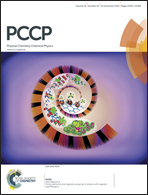Transition metal-doped BiFeO3 nanofibers: forecasting the conductivity limit
Abstract
We investigate the limiting electrical conductivity of BiFeO3 (BFO) nanofibers via first-principles modelling and experiments. Based on a semi-empirical approach, all transition metals are first screened for their suitability to form an acceptor in BFO. The resultant candidates (e.g., Ni, Cu and Ag) are further studied by more sophisticated electronic structure theory and experiments. Accordingly, a systematic approach in forecasting the electrical conduction in BFO nanofibers is established. The calculated results show that Ag+ cations prefer substitutions of Bi3+ while Ni2+ and Cu2+ prefer substitution of Fe3+ sites to form acceptors. All three metals contribute to an increased overall hole concentration which may lead to a conductivity limit in BFO. These predictions were confirmed consistently through the synthesis and electrical testing of Ni-, Cu- and Ag-doped BFO nanofibers. Finally, our results indicate that the conductivity limit is approached by Ni doping in BFO. The methodology presented here may be extended to search for the doping conductivity limits of other semiconductors of interest.


 Please wait while we load your content...
Please wait while we load your content...